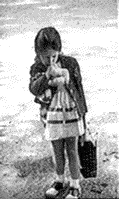The most powerful way of looking at this set of 4 pictures from the point of view of
communication theory is to realize that there are three persons here:
- a little girl
- an adult male photographer
- you (and me) as interpreters
The little girl did something, some of which appears of the photographs, the photographer
did something else most of which we (you and me) can only know indirectly (through his own
interpretations). What we can do is quite open. We could take
- a sociobiological stance and talk about the "natural" flirtiness of young females
gauging the usefulness of male for the reproduction of her genes.
[and possible ignore the ways in which this girl's performance of
"flirtiness" has no universal value in the human species to the extent
that males from certain cultures might not "understand" what was
being done so that the girl would fail in her purposes]
- a classical "cultural" stance by emphasizing how thoroughly a girl of four "knows"
major aspects of "her" culture.
[and not face squarely what may be odd about such a young child "knowing"
what to do in such a specific fashion; or, what such an interpretation
assume about internal mechanisms: can one really think that human beings
are ever driven so mechanistically by internal inputs?]
- perhaps even a stance informed by "resistance" theory which might emphasize how the girl,
by doing what she did may have prevented the photographer from doing what he
may have "wanted" to do (e.g. take "candid" photographs unmodified by the
photographer's presence).
[and possibly project a complex understanding and a process of strategic
thinking that may be hard to document, and, at the same time, ignore the
exact shape that the resistance took--which would take us back to
cultural interpretations.]
- or, finally, and most radically, the stance that what is happening here is not a display
of properties of the girl (biologically, culturally, or strategically),
or photographer, or interpreter, but rather of the interaction between them.
Specifically, it is arguable that neither girl nor photographer, initially, "knew"
what they were going to do but that each entrained each other towards taking the
position that we see the girl occupying at the end of the sequence. That is, she
can be said to "have learned" (that is changed her behavior in relation to what
the photographer must have done) rather than "exhibiting her learning."
[the difficulty here is that we must say that the photographer, too, is
"learning" (that is changing his behavior in relation to the changes
in someone else's behavior) and that, together, they end up reproducing
a stereotypical scene.]
Each of these are "interpretations" with implications for further understandings and further
research. Do note that the "open" nature of these interpretations do not change what the
girl or the photographer performed. The photographs are still there, as a potential challenge
to any interpretation. It would not be true to say that "we" can do anything we want
if we want to remain relevant to the photographs.
Last revision: January 27, 1997

